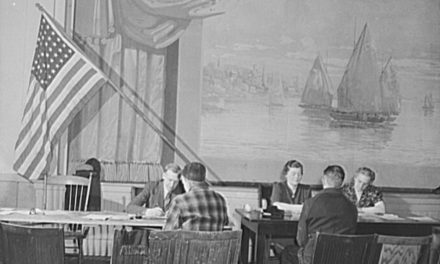Residents of New York and other major cities are preparing emergency defenses against possible Japanese air raids along after blackouts in San Francisco.
On the evening of Dec. 12, the residents of San Francisco and the larger Bay Area – from San Jose to Sacramento – waited in a deadly silent, utterly motionless city. Warned at 7:20 p.m. by familiar sirens, citizens and city workers proceeded to cloak the area in darkness. The city held its breath while planes roared overhead.
Officials cited the danger of Japanese bombers in the vicinity as the reason for the sirens’ activation, but they did not confirm the flight of enemy planes, and no bombs were dropped. The city resumed life at 10 p.m.
After the blackout, San Francisco continues to prepare for an evacuation. “No need for panic, no need for individual action in the matter of evacuation,” said Max P. Lilienthal of the Civilian Defense Council. “We want every citizen to know that a workable complete plan is ready to function should the necessity arise.”
The Pacific coast has become essential to the war effort in the last two years, because of its abundance of large manufacturing plants for aircraft production. For that reason, citizens offered a volunteer defense plan to the director of civilian defense, New York City Mayor Fiorello La Guardia. Many attempted to aid in the preparation effort for blackouts as air-raid wardens, auxiliary firemen, and window blackouts.
Although Mayor La Guardia indicated that the citizen volunteers were untrained and unprepared to respond, the effort cannot be misunderstood. Citizens across the country are gearing up for war.

The fear of potential air raids continues throughout major cities such as New York and San Francisco. From Wikimedia Commons.
General John McDonnell of the First Interceptor Command, who is responsible for receiving and dispatching information on potential air raids, announced the warning signals yesterday. The first stage, titled “yellow,” is a notification of “distant enemy approaching,” a confidential sign delivered privately to defense forces and preparation agencies. Once agencies and defense forces receive the fist signal, either the signal warning will be cancelled or a “blue” signal will follow. A blue signal confirms the raiding planes’ course. A “red” signal is issued to the public following the confirmation of the blue signal. Once a community receives a read signal, they can expect to have enemy planes overhead.
McDonnell said, “When a warning is sounded, it means that there is a flight of planes approaching at some distance from the area in which the warning is sounded.” Civilians are instructed to abide by blackout regulations until the warning signal ends.
Army officials assured the public that air raid sirens will not sound unless danger is present. Blackout protocol requires all light to be cut off, from railroad control to household flashlights. Civilians are instructed to remain indoors, refrain from the use of cigarettes and matches or any burning lights.
The Disaster Control Board received and reviewed over 140,000 applications for citizen wardens for air raid preparation for the city of New York. Instruction seminars will be held several times a week until a force of wardens is formed and each volunteer is familiar with the 16 control boxes and switches used to shut down the city’s electricity.
James Marshall, president of the Board of Education, announced that every New York City School will be given radio equipment, to enable constant communication in case of future air raid warnings during school hours. Previous warnings failed to reach a number of parochial and private schools in New York City, which had been unaware of the warning signals. The Board instructed schools to send home students who lived within a 10-minute walk from the school and hold the other students in designated safe zones in the schools.
“This is not a time to take chances,” General McDonnell said. “This is war. Everything approaching our shores must be challenged and guarded against.”
In this darkness and uncertainty, residents are left digging for answers. Who is in danger? Many citizens may wonder, whether or not they reside in prominent coastal cities, if they should fear the loss of power in their own cities and homes. How long will residents of coastal areas tiptoe on their streets, subject to surprise air raids? Are American cities in serious danger from Japanese bombers? The only certainty is that pubic behavior will be under the direction of air raid warning services for months to come.
References
Davies, Lawrence. “READY TO REMOVE SAN FRANCISCANS: Officials Tell Plans to Move Swiftly to Clear the City if Necessity Arises LATEST BLACKOUT PRAISED But Minor Defects Are Still to Be Corrected — Safes Robbed as Dark Shrouds the Area.” The New York Times. Dec 14, 1941. p. 63.
Davies, Lawrence. “SAN FRANCISCO PUT IN DARKNESS AGAIN: Blackout Covers Area for 100 Miles Inland and Lasts Two Hours Forty Minutes.” The New York Times. Dec 13, 1941. p. 13.
Davies, Lawrence. “San Francisco: Exposed Coast Region Awakes to Danger.” The New York Times. Dec 14, 1941. p. E6.
“MAYOR BACK, CHIDES CITY ON AIR RAIDS: Its Apathy Embarrassed Him While He Was Urging Others to Heed Alarms, He Says PRAISES COAST ALERTNESS But Says We Will ‘Show the Country’ — Huge Task of Preparation Pushed.” New York Times. Dec 13, 1941. p. 12
“AIR-RAID BLACKOUTS SOLELY UP TO ARMY: Brig. Gen. McDonnell Is Only Authority for Giving Them in Second Corps Area ARMY TO AUTHORIZE ALL ALERT SIGNALS RAID-ALERTS CHIEF.” New York Times. Dec 14, 2016. p. 1.





